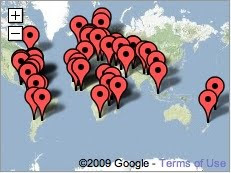So the fifth gathering (forum) heralded our first workshop. This time the topic for discussion was something that all in the room had undoubtedly come into contact with - us on the internet. The meeting was chaired by Michael Best from the Georgia Institute of Technology (the man who had earlier overseen the initiation of the YF`s own Web 2.0 generated features). The panel consisted of Tad Deriso (President and CEO of Mid-Atlantic Broadband Cooperative), Samuel Morgan (Alumni YF Fellow) and Katie Mulloy (UNICEF). The main points raised by the panel were:
Tad Deriso
The idea of OAFONs (Open Access Fibre Optic Networks) is a great one and his company has continued to connect schools and communities through four means: the Fibre Optic Networks, Aerially hung fibres, Local Access Points and Wireless Towers. Tad mentioned the troubles experienced in receiving permission to actually provide these services (laying Fibres in particular) which was often resolved by offering municipal bodies with “free Fibre” (2 or 3 strands for their purposes).
Michael Best
A short overview of Web 2.0 features and utilities describing them as Rich (large images, documents, videos, etc.), Interactive (voice, audio chat) and most importantly user based (done by us). A prerequisite for the use Web 2.0 is for this reason access to broadband networks. Another important point raised by Michael was the need to build literacy and awareness in terms of privacy and security. He posed the question if mobile technology might be the solution to the issue of lack of broadband when using 2.0 technology.
Katie Mulloy
A new dimension was added to the attending YF representatives understanding of UNICEFs activities by describing the technical developments and activities which they have and continue to undertake. The example which she provided was that of the BEE: an open-source system in all its software, hardware and design - which can be replicated using off-the-shelf components.
Samuel Morgan
A speech all about “you” – that is that “we” utilize the power of Web 2.0 technologies in terms of “collaboration, open standards and interoperability” because “you can become a publisher of content. In order to display the value of Web 2.0 Sam provided a number of real-life examples: Waterwiki, NATA (Venezuela) and the UN online volunteer site to provide small-loan financial supports.
Following the tea-break the workshop reconvened with a presentation by the YF Web 2.0 working-group’s representatives – Maps & Images, Documents and Blogging. Those representatives then remained on stage joining the panel for the continuation of workshops theme (see title). Discussions grew more heated as controversial topics such as copyright, inhibitions due to politics, health issues and the threats to privacy by being able to access vast quantities of personal information through the internet – in particular through Web 2.0 features – and individuals apparent unawareness of the possible repercussions thereof. Even conspiracy theories were brought into debate of the ”Big Brother”, whether that be government organizations or otherwise, watching our every move.
The debate could well have kept going; however time was against us and so it came to a close. Day 3 FINI!
Tad Deriso
The idea of OAFONs (Open Access Fibre Optic Networks) is a great one and his company has continued to connect schools and communities through four means: the Fibre Optic Networks, Aerially hung fibres, Local Access Points and Wireless Towers. Tad mentioned the troubles experienced in receiving permission to actually provide these services (laying Fibres in particular) which was often resolved by offering municipal bodies with “free Fibre” (2 or 3 strands for their purposes).
Michael Best
A short overview of Web 2.0 features and utilities describing them as Rich (large images, documents, videos, etc.), Interactive (voice, audio chat) and most importantly user based (done by us). A prerequisite for the use Web 2.0 is for this reason access to broadband networks. Another important point raised by Michael was the need to build literacy and awareness in terms of privacy and security. He posed the question if mobile technology might be the solution to the issue of lack of broadband when using 2.0 technology.
Katie Mulloy
A new dimension was added to the attending YF representatives understanding of UNICEFs activities by describing the technical developments and activities which they have and continue to undertake. The example which she provided was that of the BEE: an open-source system in all its software, hardware and design - which can be replicated using off-the-shelf components.
Samuel Morgan
A speech all about “you” – that is that “we” utilize the power of Web 2.0 technologies in terms of “collaboration, open standards and interoperability” because “you can become a publisher of content. In order to display the value of Web 2.0 Sam provided a number of real-life examples: Waterwiki, NATA (Venezuela) and the UN online volunteer site to provide small-loan financial supports.
Following the tea-break the workshop reconvened with a presentation by the YF Web 2.0 working-group’s representatives – Maps & Images, Documents and Blogging. Those representatives then remained on stage joining the panel for the continuation of workshops theme (see title). Discussions grew more heated as controversial topics such as copyright, inhibitions due to politics, health issues and the threats to privacy by being able to access vast quantities of personal information through the internet – in particular through Web 2.0 features – and individuals apparent unawareness of the possible repercussions thereof. Even conspiracy theories were brought into debate of the ”Big Brother”, whether that be government organizations or otherwise, watching our every move.
The debate could well have kept going; however time was against us and so it came to a close. Day 3 FINI!



.jpeg)

No comments:
Post a Comment